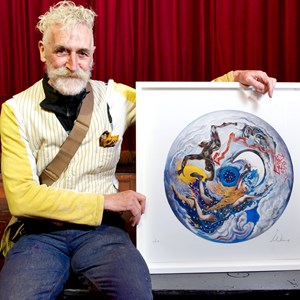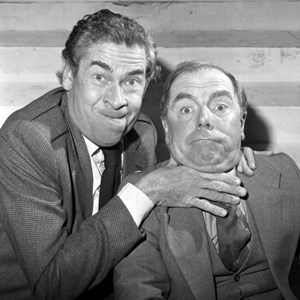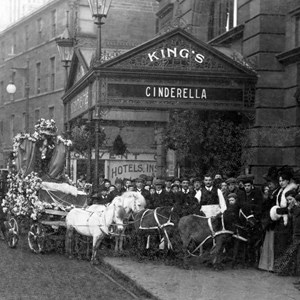Celebrating The Great Lafayette
The site of the Festival Theatre has been occupied by a bewildering succession of circuses and performance halls since 1830, some of which were closed down and rebuilt, some of which were swept aside by fire. The shortlived Southminster Theatre was gutted by a fire in 1875, its replacement the Queens Theatre burned down in 1877 and its successor Newsome’s Circus went down in flames in 1879.
The most documented fire on the Nicolson Street happened on Tuesday 9 May 1911 when the Empire Theatre Palace – which had survived for nearly 19 years - burnt to the ground, taking the life of 11 people including the famous illusionist ‘The Great Lafayette’.
The Great Lafayette, born as Sigmund Neuberger, was one of the most celebrated illusionists of the early 20th century. He travelled the world bringing his mystifying illusions and elaborate quick-changes to the masses, entertaining thousands at every performance, always accompanied by his beloved friend Beauty, a small cross-bred terrier that Houdini gifted to him. Both on and off stage, he was extravagant and lavish and his spectacular stage shows made him the highest paid entertainer in the theatre at the time.
His appearance at the Empire Theatre Palace was met with high expectation, with 3,000 spectators packing the theatre on that fateful evening. After an outstanding performance by the company, the show culminated with the ‘The Lion’s Bride’, a showstopping quick-change finale. The exotic illusion, set in a Persian harem and decorated with ornate long curtains, depicted fire-eaters, jugglers and contortionists and saw The Great Lafayette change places with a real lion on stage. As he was taking a bow, a lamp fell on the heavily carpeted set, quickly setting the stage on fire.
Thinking the fire was part of the performance, the audience was brought to its feet by a quick-thinking conductor instructing the orchestra to play God Saved the King. Every member of the audience was evacuated but the performers on stage were not so lucky. The safety curtain came down, but got jammed, creating a back-draught which fuelled the fire on stage. Locked doors backstage, insisted upon by an illusionist scared of having his secrets stolen, meant that many of the company were trapped. It took three hours to bring the fire under control, and eleven people perished in the fire that evening. It is rumoured The Great Lafayette managed to escape the inferno but returned to save his horse.
In the early hours of the morning, a charred body with Lafayette’s clothing was found and cremated in preparation for his funeral. Two days later, the ‘real’ Lafayette body was found by dumbfounded fire officers, who recognised the real diamond rings on his fingers. It turned out the previous body was that of his body double.
Five days later, thousands of spectators took to the streets of Edinburgh to say goodbye to The Great Lafayette, who was to be buried in Piershill Cemetery next to his beloved companion Beauty, who had died a couple of weeks before him of suspected apoplexy. To this day, The Great Lafayette’s tomb can be visited in the northeast cemetery.
Almost 110 years later, we celebrate his amazing life and death with a revival of The Great Lafayette exhibition display at the Festival Theatre, 10am to 6pm from Monday 27 May until Sat 8 June (except Sunday, 2 June). The revival of this exhibition display from 2011 is part of our 25 Years of the Festival Theatre celebrations.
Footage from the afermath of the fire on 1911
Stories you might like


Story
Thursday 11 October 2018

Story
Tuesday 31 July 2018





